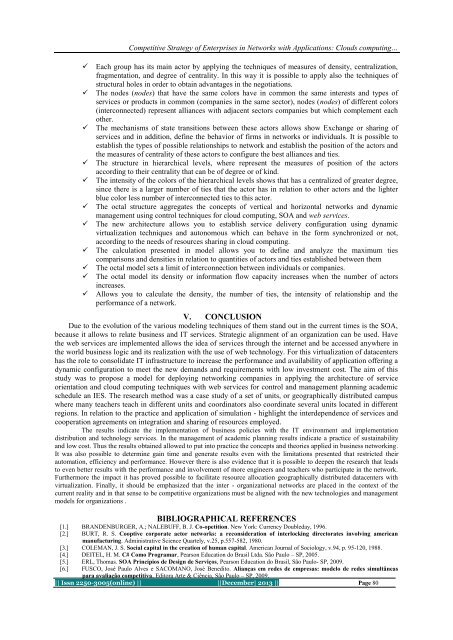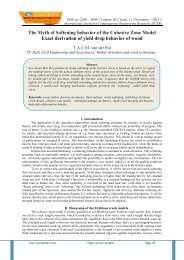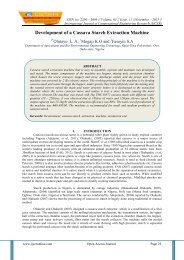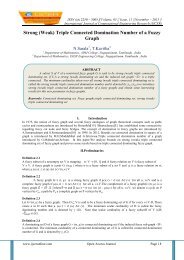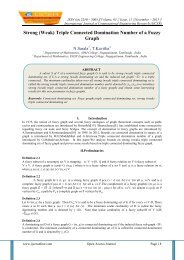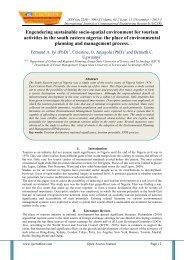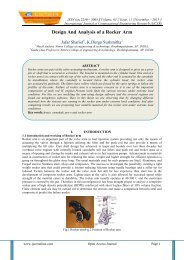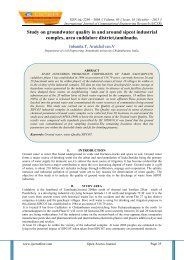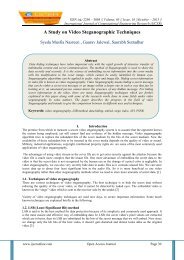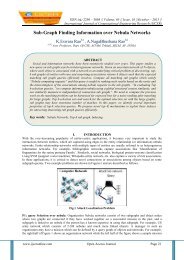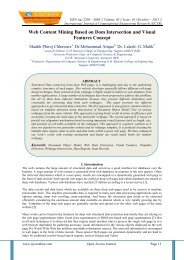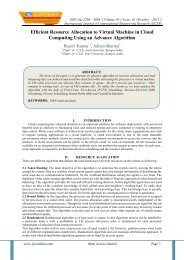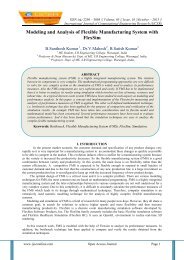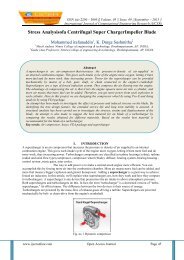L031202063081.pdf
International Journal of Computational Engineering Research(IJCER) is an intentional online Journal in English monthly publishing journal. This Journal publish original research work that contributes significantly to further the scientific knowledge in engineering and Technology
International Journal of Computational Engineering Research(IJCER) is an intentional online Journal in English monthly publishing journal. This Journal publish original research work that contributes significantly to further the scientific knowledge in engineering and Technology
You also want an ePaper? Increase the reach of your titles
YUMPU automatically turns print PDFs into web optimized ePapers that Google loves.
Competitive Strategy of Enterprises in Networks with Applications: Clouds computing…<br />
Each group has its main actor by applying the techniques of measures of density, centralization,<br />
fragmentation, and degree of centrality. In this way it is possible to apply also the techniques of<br />
structural holes in order to obtain advantages in the negotiations.<br />
The nodes (nodes) that have the same colors have in common the same interests and types of<br />
services or products in common (companies in the same sector), nodes (nodes) of different colors<br />
(interconnected) represent alliances with adjacent sectors companies but which complement each<br />
other.<br />
The mechanisms of state transitions between these actors allows show Exchange or sharing of<br />
services and in addition, define the behavior of firms in networks or individuals. It is possible to<br />
establish the types of possible relationships to network and establish the position of the actors and<br />
the measures of centrality of these actors to configure the best alliances and ties.<br />
The structure in hierarchical levels, where represent the measures of position of the actors<br />
according to their centrality that can be of degree or of kind.<br />
The intensity of the colors of the hierarchical levels shows that has a centralized of greater degree,<br />
since there is a larger number of ties that the actor has in relation to other actors and the lighter<br />
blue color less number of interconnected ties to this actor.<br />
The octal structure aggregates the concepts of vertical and horizontal networks and dynamic<br />
management using control techniques for cloud computing, SOA and web services.<br />
The new architecture allows you to establish service delivery configuration using dynamic<br />
virtualization techniques and autonomous which can behave in the form synchronized or not,<br />
according to the needs of resources sharing in cloud computing.<br />
The calculation presented in model allows you to define and analyze the maximum ties<br />
comparisons and densities in relation to quantities of actors and ties established between them<br />
The octal model sets a limit of interconnection between individuals or companies.<br />
The octal model its density or information flow capacity increases when the number of actors<br />
increases.<br />
Allows you to calculate the density, the number of ties, the intensity of relationship and the<br />
performance of a network.<br />
V. CONCLUSION<br />
Due to the evolution of the various modeling techniques of them stand out in the current times is the SOA,<br />
because it allows to relate business and IT services. Strategic alignment of an organization can be used. Have<br />
the web services are implemented allows the idea of services through the internet and be accessed anywhere in<br />
the world business logic and its realization with the use of web technology. For this virtualization of datacenters<br />
has the role to consolidate IT infrastructure to increase the performance and availability of application offering a<br />
dynamic configuration to meet the new demands and requirements with low investment cost. The aim of this<br />
study was to propose a model for deploying networking companies in applying the architecture of service<br />
orientation and cloud computing techniques with web services for control and management planning academic<br />
schedule an IES. The research method was a case study of a set of units, or geographically distributed campus<br />
where many teachers teach in different units and coordinators also coordinate several units located in different<br />
regions. In relation to the practice and application of simulation - highlight the interdependence of services and<br />
cooperation agreements on integration and sharing of resources employed.<br />
The results indicate the implementation of business policies with the IT environment and implementation<br />
distribution and technology services. In the management of academic planning results indicate a practice of sustainability<br />
and low cost. Thus the results obtained allowed to put into practice the concepts and theories applied in business networking.<br />
It was also possible to determine gain time and generate results even with the limitations presented that restricted their<br />
automation, efficiency and performance. However there is also evidence that it is possible to deepen the research that leads<br />
to even better results with the performance and involvement of more engineers and teachers who participate in the network.<br />
Furthermore the impact it has proved possible to facilitate resource allocation geographically distributed datacenters with<br />
virtualization. Finally, it should be emphasized that the inter - organizational networks are placed in the context of the<br />
current reality and in that sense to be competitive organizations must be aligned with the new technologies and management<br />
models for organizations .<br />
BIBLIOGRAPHICAL REFERENCES<br />
[1.] BRANDENBURGER, A.; NALEBUFF, B. J. Co-opetition. New York: Currency Doubleday, 1996.<br />
[2.] BURT, R. S. Cooptive corporate actor networks: a reconsideration of interlocking directorates involving american<br />
manufacturing. Administrative Science Quartely, v.25, p.557-582, 1980.<br />
[3.] COLEMAN, J. S. Social capital in the creation of human capital. American Journal of Sociology, v.94, p. 95-120, 1988.<br />
[4.] DEITEL, H. M. C# Como Programar, Pearson Education do Brasil Ltda. São Paulo – SP, 2005.<br />
[5.] ERL, Thomas. SOA Princípios de Design de Serviços, Pearson Education do Brasil, São Paulo- SP, 2009.<br />
[6.] FUSCO, José Paulo Alves e SACOMANO, José Benedito. Alianças em redes de empresas: modelo de redes simultâneas<br />
para avaliação competitiva, Editora Arte & Ciência, São Paulo – SP, 2009.<br />
|| Issn 2250-3005(online) || ||December| 2013 || Page 80


